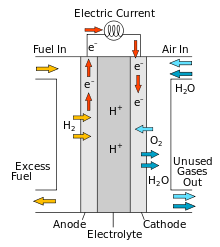Protonic ceramic fuel cell
A protonic ceramic fuel cell or PCFC is a fuel cell based around a ceramic electrolyte material that exhibits high protonic conductivity at elevated temperatures.

PCFCs share the thermal and kinetic advantages of high temperature operation at 700 degrees Celsius with molten carbonate and solid oxide fuel cells, while exhibiting all of the intrinsic benefits of proton conduction in proton exchange membrane fuel cells (PEMFC) and phosphoric acid fuel cells (PAFC). The high operating temperature is necessary to achieve very high electrical conversion efficiency with hydrocarbon fuels. PCFCs can operate at high temperatures and electrochemically oxidize fossil fuels directly at the anode. This eliminates the intermediate step of producing hydrogen through the costly reforming process. Gaseous molecules of the hydrocarbon fuel are absorbed on the surface of the anode in the presence of water vapor, and hydrogen atoms are efficiently stripped off to be absorbed into the electrolyte, with carbon dioxide as the primary reaction product. Because PCFCs use a solid electrolyte, it cannot dry out as membranes in PEM fuel cells do, and there is no risk of liquid leaking out as with PAFCs.
Further reading
- Service, Robert F. (March 12, 2019). "New fuel cell could help fix the renewable energy storage problem". Science. doi:10.1126/science.aax3098. Retrieved March 14, 2019.
- Duan, Chuancheng, et al. "Readily processed protonic ceramic fuel cells with high performance at low temperatures." Science 349.6254 (2015): 1321-1326.
- Duan, Chuancheng, et al. "Highly durable, coking and sulfur tolerant, fuel-flexible protonic ceramic fuel cells." Nature557.7704 (2018): 217.
- Duan, Chuancheng, et al. "Highly efficient reversible protonic ceramic electrochemical cells for power generation and fuel production." Nature Energy 4.3 (2019): 230.